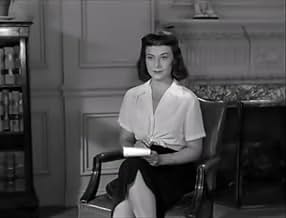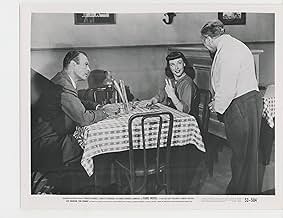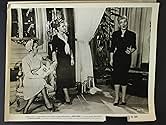Aggiungi una trama nella tua linguaThe story of a dress and the effects it has on the women who wear it begs the question of where is O. Henry when he is needed. "Nude at Midnight", a new and daring Paris-style creation is wo... Leggi tuttoThe story of a dress and the effects it has on the women who wear it begs the question of where is O. Henry when he is needed. "Nude at Midnight", a new and daring Paris-style creation is worn by Gogo Montaine to try and ensnare the Rajah of Kim-Kepore but he is attracted to Lisa... Leggi tuttoThe story of a dress and the effects it has on the women who wear it begs the question of where is O. Henry when he is needed. "Nude at Midnight", a new and daring Paris-style creation is worn by Gogo Montaine to try and ensnare the Rajah of Kim-Kepore but he is attracted to Lisa, the girl who modeled the dress. Marion Parmalee dons the gown to charm her husband's ret... Leggi tutto
- Prince Romanoff
- (as Prince Michael Romanoff)
Recensioni in evidenza
There are some small links in the stories besides the dress. For example, Tom Conway appears as the turban wearing Maharajah of Kim-Kepore in the first episode and reappears briefly in the fourth episode. Eva Gabor and Conway are delightful in this first story of two people conning each other. Paulette Godard, looking like a tall Bettie Page, shines in the dress in the second wife vs. secretary tale. In the funniest line in the movie, she asks a salesgirl for a Marilyn Maxwell type dress, "clingy and swinging." Marilyn Maxwell then dons the dress in the third episode. She uses it to tease and get a promotion for her husband from her boss, played by the always delightful Cecil Kellaway. Only the fourth episode with Barbara Lawrence doesn't really sparkle. It involves a girl trying to get her long time boyfriend to finally propose.
Some reviewers seem to be disappointed with the limited nature of the production. It is intended to be a "B" film with a few "B" list stars. Three hits out of four is fine. There are plenty of giggles for the hour and twenty minutes. The film looks forward to the more sophisticated and daring sex comedies with Doris Day and Marilyn Monroe that would be coming in the later 1950s.
Eva Gabor comes off reasonably well in the opening episode, trying her best to catch turban wearing Maharajah Tom Conway (!?!), the latter looking even more bored than usual. Gabor charges the dress to one of her (unsuspecting) admirers, but gets short changed herself when Conway sets his eyes on a ravishing Laurette Luez in a casino.
Next on the hit list is Paulette Goddard as the secretary of a lawyer (Leif Erickson), hoping to lure him away from his shrewish wife by getting him to take her to dinner while she wears that dress. A decidedly lightweight episode, Goddard is game but looking past her feisty, vivacious prime, though still able to show off a pair of attractive legs as bait for the lawyer.
The third episode involves Marilyn Maxwell as the wife of a salesman hoping to use the attraction of that dress on her husband's retiring boss (Cecil Kellaway), so that he will appoint hubby as his replacement. Maxwell, by the way, receives top billing in this film, a sad comment on the decline of Goddard's career, since she was once a far bigger Hollywood star than Maxwell could ever possibly be. A frail looking Florence Bates appears as Kellaway's wife in what turned out to be her last film role.
The final story features, as opposed to the veterans, up-and-coming Barbara Lawrence as a young woman seeking to use that dress to get her non committing boyfriend (Robert Hutton) to finally pop the big question to her. This episode is primarily set in Romanoff's Restaurant in LA, with curtains and paper mache "walls" serving as a set, as well as a grim reminder of just how cheap the budget of this film must have been. Of note, though, Prince Michael Romanoff makes an appearance himself here, playing the role of matchmaker. El Brendel briefly turns up, too, as Lawrence's father.
A minor time waster, it's always a little sad to see film veterans forced to collect their paychecks with such meager material. Paris Model (the title referring to the dress, not a person) gets the occasional broadcast on Turner Classic Movies.
New York secretary Paulette Goddard (as Betty Barnes) tries to seduce her married boss Leif Erickson (as Edgar Blevins) by showing her legs, wearing the low-cut dress, and getting him drunk. They should have cast someone closer to Ms. Goddard's age to play Mr. Erikson's wife. Third story finds bosomy blonde Marilyn Maxwell (as Marion Parmalee) filling the dress to entice old Cecil Kellaway (as Patrick "PJ" Sullivan) into promoting her husband. Finally, in California, curvy Barbara Lawrence (as Marta Jensen) wears the dress to pop a marriage proposal from Robert Hutton (as Charlie Johnson).
*** Paris Model (11/10/53) Alfred E. Green ~ Marilyn Maxwell, Paulette Goddard, Eva Gabor, Barbara Lawrence
Because of that structural issue and because this is a woman's picture it is somewhat less interesting to me. Nonetheless, the talent here is always competent, the lines are frequently interesting -- Tom Conway, as a Maharajah, is offered a succession of haute cuisine dishes but prefers simple fare -- and the result is highly watchable.
So cut to more than 30 years later and I finally see "Paris Model" once again. The shock starts with the credits: Marilyn Maxwell, at best a "B"-level actress, is billed over Paulette Goddard, who'd headlined some very big movies not that many years earlier. Poor Paulette even is called upon to refer to Maxwell in one scene--and, really, who'd go to a store looking for a "Marilyn Maxwell-type dress"? (I'm guessing that Maxwell, or perhaps a wealthy associate of hers, had some money in the production.) The shock continues as the credits continue, superimposed as they are over a somewhat seedy-looking blonde model. Clearly, this is going to be a really cheap film, and the name of Albert Zugsmith as producer verifies that quite explicitly. So does the screen credit that informs us that the apparently haute-couture gown of the title was the creation of "Junior Sophisticates, New York." (A couple of the other fashions in the show look Simplicity tacky.)
As another reviewer has noted, it's a "Tales of Manhattan"-type yarn showing the progress of an evening gown called Nude at Midnight from Paris original to thrift-store knockoff. From Paris to New York to the Midwest to L.A. it goes, but clearly we've never left the sound stage. The sets are small and rather cramped, and scenes supposedly set in large spaces, like Romanoff's restaurant, take place only in small corners that can only hold a few people. While the pace is adequate (director Green had been responsible for some big films, back in the day), the dialog tries for wit without getting very far, and some good actors are seen at, let's be kind here, less than optimal advantage. Eva Gabor, in the first segment, comes off best--she can do "coquettish" in her sleep and seems to be enjoying herself. The once-mighty Goddard tries to sparkle, but the photography does her no favors at all. Maxwell is generic, as she usually was, and Barbara Lawrence is adequate. The supporting actors are a surprisingly sturdy lot: Tom Conway (looking disinterested), Leif Ericson, Cecil Kellaway, a frail-looking Florence Bates in her final role, perennial male ingénue Robert Hutton, and even El Brendel as Lawrence's yumpin-yiminy dad. None of them get opportunities anywhere near their best roles, but at least they're there. So "Paris Model" can't be recommended to a casual viewer looking for wit and sparkle, but for movie buffs it offers a good deal of interest--even when much of that interest involves tut-tutting over how far into B-movie land the once-mighty have fallen.
Lo sapevi?
- QuizFinal film of actress Florence Bates.
- Curiosità sui creditiCecil Kellaway, Robert Hutton, Leif Erickson, Tom Conway and those Paris Models.
I più visti
Dettagli
- Tempo di esecuzione1 ora 21 minuti
- Colore
Contribuisci a questa pagina



























